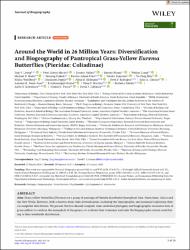/admin/item?itemID=5be85d4d-76c2-4918-a333-d4023eef1a5b
Around the world in 26 million years : diversification and biogeography of pantropical Grass-yellow Eurema butterflies (Pieridae: Coliadinae)

View/
Type of Access
OpenMaterial Type
ArticleType of Content
Scientific researchLanguage
EnglishCollection
- Investigación ambiental [1749]
Metadata
Show full item record| Abstract: | Aim: Grass-yellow butterflies (Eurema) are a group of pantropical Pieridae distributed throughout Asia, Australasia, Africa and the New World. However, little is known about their diversification, including the biogeographic mechanism(s) explaining their circumglobal distribution. We present the first densely sampled, time-calibrated phylogeny and biogeographic reconstruction of grass-yellows to confirm the monophyly of the genera, re-evaluate their taxonomy and infer the biogeographic events contributing to their worldwide distribution.
Location: Global tropics and subtropics.
Taxon: The butterfly tribe Euremini (Pieridae: Coliadinae).
Methods: We analysed up to 391 genetic loci from 126 samples of 66 ingroup species. Divergence dating was accomplished in a Bayesian phylogenetic framework using secondary calibration points, and maximum likelihood models of various biogeographic models were fitted to the data using the R package BioGeoBEARS. We used the best fitting model to estimate relative dispersal events with biogeographical stochastic mapping. Finally, we estimated branch-specific speciation and extinction rates to assess the diversification history of the group.
Results
Different phylogenomic analyses converged on similar topologies with robust support. Grass-yellows emerged ca. 26 Mya in the New World, and a single extant lineage dispersed to Asia in the early Miocene, where they diversified and dispersed to Africa and Australasia. The fastest rates of diversification occurred in the Old World tropics during the late Miocene. Many of the grass-yellow genera were either paraphyletic or polyphyletic as traditionally circumscribed. To maintain nomenclatural stability, we place all grass-yellows in Eurema sensu lato and recognise two subgenera: Eurema (Abaeis) and Eurema (Eurema).
Main conclusions: Grass-yellow butterflies originated in the Americas and attained their global distributional patterns via dispersal. The Indo-Australian and Caribbean archipelagoes seem to have accelerated the diversification of the group, and movement in and out of these island regions was frequent. Although the traditional view of founder-event speciation envisions migrants from large landmasses (‘mainland’) colonising smaller landmasses (‘islands’), we find that island to mainland dispersal and differentiation were equally or more common. |
| Author(s): | Leong, Jing V.
Matos-Maraví, Pável Núñez, Rayner Nunes, Renato Liang, Weijun Braby, Michael F. Doleck, Tenzing Aduse-Poku, Kwaku Inayoshi, Yutaka Hsu, Yu-Feng Wahlberg, Niklas Peggie, Djunijanti Mohagan, Alma B. Mohagan, Dave P. Genaro, Julio A. Perez-Asso, Antonio R. Kunte, Krushnamegh Martins, Dino J. Sáfián, Szabolcs Kawahara, Akito Y. Pierce, Naomi E. Lohman, David J. |
| Date: | 2025 |
| Published: | Journal of Biogeography [early view] |
| Citation: | Leong, J. V., Matos-Maraví, P., Núñez, R., Nunes, R. et al. (2025). Around the world in 26 million years: diversification and biogeography of pantropical Grass-yellow Eurema butterflies (Pieridae: Coliadinae). Journal of Biogeography [early view]. Recuperado de: |
| URI: | https://bvearmb.do/handle/123456789/5956
|

